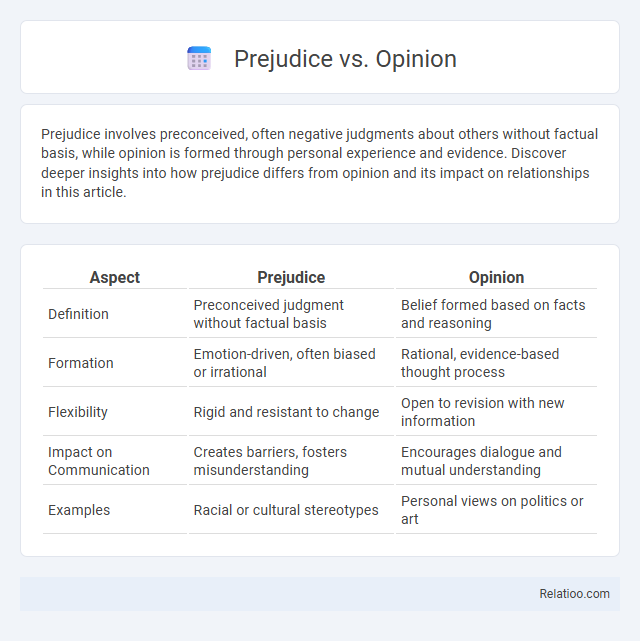Prejudice involves preconceived, often negative judgments about others without factual basis, while opinion is formed through personal experience and evidence. Discover deeper insights into how prejudice differs from opinion and its impact on relationships in this article.
Table of Comparison
| Aspect | Prejudice | Opinion |
|---|---|---|
| Definition | Preconceived judgment without factual basis | Belief formed based on facts and reasoning |
| Formation | Emotion-driven, often biased or irrational | Rational, evidence-based thought process |
| Flexibility | Rigid and resistant to change | Open to revision with new information |
| Impact on Communication | Creates barriers, fosters misunderstanding | Encourages dialogue and mutual understanding |
| Examples | Racial or cultural stereotypes | Personal views on politics or art |
Understanding Prejudice and Opinion: Key Definitions
Prejudice involves forming rigid and often negative judgments about individuals or groups based on stereotypes without sufficient knowledge or experience, whereas opinion reflects a personal belief or attitude shaped by individual experiences and reasoning. Understanding prejudice requires recognizing its impact on social bias and discrimination, while opinions are subjective and can evolve with new information. You must differentiate between these concepts to foster open-mindedness and promote critical thinking in social interactions.
Historical Roots of Prejudice and Opinion
Prejudice often originates from deep-seated historical biases tied to social, cultural, or ethnic divisions, shaping collective attitudes that resist change despite contradicting evidence. Opinions, conversely, are typically formed through personal experiences and information processing, allowing for adaptability and evolution over time. Understanding the historical roots of prejudice reveals how entrenched stereotypes and systemic inequalities perpetuate discrimination beyond mere individual viewpoints.
The Psychology Behind Prejudice
Prejudice stems from deep-rooted psychological mechanisms such as stereotyping and in-group bias, often influenced by fear, socialization, and cognitive shortcuts. Unlike opinions, which are formed through individual beliefs and experiences, prejudice involves irrational and fixed negative attitudes towards groups without factual basis. Understanding the psychology behind prejudice reveals how implicit biases operate unconsciously, reinforcing discrimination and social division.
How Opinions Are Formed
Opinions are formed through a combination of personal experiences, information processing, and social influences, shaping how you interpret facts and events. Unlike prejudice, which is an unfounded, often negative bias toward a group, opinions can be flexible and change with new evidence or perspectives. Understanding this distinction helps you critically evaluate your beliefs and avoid unconscious prejudices.
Prejudice vs Opinion: Core Differences
Prejudice involves preconceived judgments based on stereotypes or insufficient information, often leading to unfair treatment, while opinion is a personal belief or judgment formed through reflection or experience. You form opinions through critical thinking and evidence evaluation, whereas prejudice stems from bias and emotional judgment without factual basis. Understanding these core differences helps in recognizing when your views may be influenced by unfounded biases rather than informed opinions.
Social Impact of Prejudice Compared to Opinion
Prejudice, unlike opinion, is a preconceived judgment based on stereotypes and lacks factual basis, often resulting in discrimination and social exclusion. Your understanding of prejudice's social impact highlights how it can perpetuate inequality, harm community cohesion, and fuel systemic injustice. Opinions, by contrast, may express personal beliefs but do not inherently cause the widespread social harm associated with prejudiced attitudes.
Identifying Prejudice in Everyday Life
Prejudice involves preconceived, often negative judgments about individuals or groups without factual basis, unlike opinions that are subjective beliefs based on personal experience or reasoning. Identifying prejudice in everyday life requires observing biased language, stereotyping, or unfair treatment that dismisses individual merit or diversity. Your awareness of these subtle signs helps challenge and reduce prejudice, fostering a more inclusive environment.
The Role of Media in Shaping Opinion and Prejudice
The media plays a pivotal role in shaping public opinion and prejudice by selectively presenting information that influences perception and emotional responses. Through repetitive framing and biased representation, media outlets can embed stereotypes and reinforce existing prejudices, often blurring the line between objective opinion and unfounded bias. This manipulation affects societal attitudes, making critical media literacy essential to distinguish between informed opinion and prejudiced narratives.
Strategies to Overcome Prejudice and Encourage Open Opinions
Overcoming prejudice involves implementing strategies such as promoting empathy through perspective-taking exercises and facilitating intergroup dialogues that challenge stereotypes and biases. Encouraging open opinions requires creating safe spaces where individuals feel respected and heard, fostering active listening skills, and emphasizing the value of diverse viewpoints in decision-making processes. Educational programs aimed at increasing cultural competence and critical thinking further help dismantle preconceived notions, enabling a more inclusive and understanding community.
Building a Culture of Tolerance and Critical Thinking
Prejudice involves preconceived, often negative judgments without factual basis, whereas opinion reflects personal beliefs formed through experience or reasoning. Building a culture of tolerance and critical thinking requires challenging prejudices by encouraging open dialogue and evidence-based analysis of opinions. You can foster understanding by promoting empathy and educating others to discern biases, ultimately creating a more inclusive and respectful community.

Infographic: Prejudice vs Opinion
 relatioo.com
relatioo.com